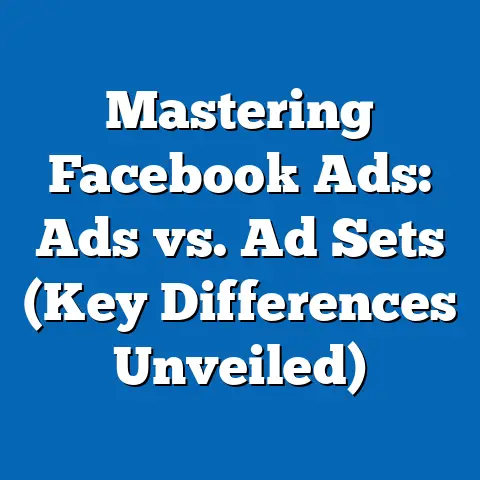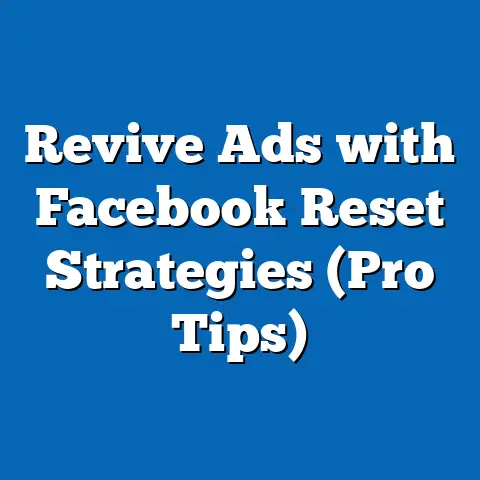Master iOS Updates for Facebook Ads Success (Essential Strategies)
In a world where mobile technology evolves at an unprecedented pace, I’ve noticed marketers often find themselves playing catch-up, grappling with innovations designed to enhance their advertising reach. It’s a paradox, isn’t it? These advancements are meant to make our lives easier, yet they often throw a wrench into our carefully crafted marketing strategies. Nowhere is this more evident than in the ever-changing landscape of iOS updates and their impact on Facebook Ads.
Understanding iOS Updates and Their Impact on Facebook Ads
To effectively address the challenges posed by iOS updates, it’s crucial to understand the updates themselves and their direct impact on Facebook advertising. It’s not just about acknowledging that things have changed; it’s about understanding how and why they’ve changed, allowing us to adapt our strategies with precision.
Overview of iOS Updates
Over the past few years, Apple has rolled out a series of significant iOS updates, each bringing changes to user experience and data privacy. These updates are designed to enhance user control over their data, but they’ve also introduced complexities for marketers.
- iOS 14.5 (April 2021): This update introduced App Tracking Transparency (ATT), requiring apps to explicitly ask for user permission to track their activity across other companies’ apps and websites. This was a game-changer, significantly impacting the availability of data for personalized advertising.
- iOS 15 (September 2021): Focused on enhancing user privacy and security, iOS 15 introduced features like Mail Privacy Protection, which hides users’ IP addresses and prevents senders from knowing if an email has been opened. This affected email marketing campaigns and, indirectly, Facebook Ads targeting based on email lists.
- Subsequent Updates (iOS 16, iOS 17): These updates continued to refine privacy features and introduced new ways for users to control their data. They also included enhancements to Apple’s own advertising platform, Search Ads, potentially shifting some advertising spend away from Facebook.
These updates are not just about adding new features; they represent a fundamental shift in how Apple views user data and privacy. As marketers, we need to understand this philosophical shift to craft strategies that align with user expectations and Apple’s guidelines.
How iOS Updates Affect User Privacy
The core of these updates, particularly ATT, revolves around empowering users with more control over their data. Before iOS 14.5, app tracking was often the default, with users having to actively opt-out. Now, users are presented with a clear choice: allow tracking or ask the app not to track.
This simple change has had a profound impact. Many users, given the choice, have opted out of tracking. This means less data is available to advertisers for:
- Targeting: Precise targeting based on user behavior and interests has become more challenging.
- Measurement: Accurately attributing conversions and measuring the ROI of ad campaigns has become more difficult.
- Personalization: Delivering highly personalized ad experiences has become less feasible.
The implications of these privacy changes are far-reaching. It’s not just about having less data; it’s about the quality of the data we have. The data we do collect is often less comprehensive and less reliable, making it harder to draw accurate conclusions about campaign performance.
The Ripple Effect on Facebook Advertising
The privacy changes introduced by iOS updates have had a significant ripple effect on Facebook advertising, impacting various aspects of campaign management.
- Reduced Audience Sizes: As fewer users opt into tracking, the available audience sizes for targeted ads have shrunk. This can lead to increased competition for ad placements and higher costs.
- Less Accurate Attribution: Facebook’s ability to accurately attribute conversions to specific ads has been compromised. This makes it harder to determine which ads are truly driving results and which are not.
- Delayed Reporting: The aggregated nature of the data that Facebook now relies on means that reporting can be delayed. This makes it harder to make timely adjustments to campaigns.
- Impact on Retargeting: Retargeting campaigns, which rely on tracking users who have previously interacted with a website or app, have been significantly affected. With fewer users being tracked, retargeting audiences are smaller and less effective.
I’ve seen firsthand how these changes have impacted campaign performance. One of my clients, a popular e-commerce brand, saw a significant drop in conversion rates after the introduction of ATT. Their retargeting campaigns, which had previously been a major source of revenue, became far less effective. We had to completely rethink their advertising strategy to adapt to the new reality.
Key Takeaway: Understanding the specific ways in which iOS updates affect Facebook Ads is the first step towards adapting your strategies. By recognizing the challenges, you can begin to explore solutions and implement strategies to mitigate the impact.
Next Steps: Take some time to analyze your own Facebook Ads performance data. Look for trends and patterns that might indicate the impact of iOS updates. Pay particular attention to metrics like audience size, attribution accuracy, and conversion rates. This analysis will help you identify areas where you need to focus your efforts.
Adapting to the Changes in User Behavior
With iOS updates significantly altering the advertising landscape, it’s more crucial than ever to understand how user behavior has shifted. We can no longer rely on the same assumptions and tactics that worked before. Instead, we need to adapt our strategies to align with the evolving expectations and preferences of privacy-conscious users.
Shifts in Consumer Expectations
The introduction of ATT and other privacy-focused features has led to a significant shift in consumer expectations regarding data privacy. Users are now more aware of how their data is being collected and used, and they’re more likely to demand transparency and control.
- Increased Privacy Awareness: Consumers are more informed about the privacy implications of sharing their data. They’re more likely to scrutinize app permissions and opt-out of tracking if they feel their privacy is being compromised.
- Demand for Transparency: Users want to know why their data is being collected and how it’s being used. They expect businesses to be transparent about their data practices and to provide clear explanations.
- Preference for Personalized Experiences: While users are concerned about privacy, they still appreciate personalized experiences. The challenge is to deliver personalization in a way that respects user privacy and builds trust.
I’ve noticed that users are more receptive to ads that are relevant and non-intrusive. They’re more likely to engage with ads that provide value and that don’t feel like an invasion of their privacy. This means that marketers need to focus on creating ad experiences that are both personalized and respectful.
Analyzing Audience Insights
To understand these shifting demographics and preferences, Facebook’s Audience Insights tool becomes invaluable. This tool allows you to analyze the characteristics and behaviors of your target audience, providing insights into their interests, demographics, and online activities.
- Demographic Data: Understand the age, gender, location, and education level of your audience.
- Interests: Discover the topics and pages that your audience is interested in.
- Behaviors: Analyze the online activities of your audience, such as their purchase behavior and device usage.
- Page Likes: See which pages your audience likes on Facebook, providing insights into their interests and preferences.
By leveraging Audience Insights, you can gain a deeper understanding of your target audience and tailor your ad campaigns accordingly. This is particularly important in the wake of iOS updates, as it allows you to refine your targeting and messaging to resonate with privacy-conscious users.
Creating User-Centric Campaigns
The key to success in the new iOS landscape is to create user-centric campaigns that prioritize privacy and build trust. This means focusing on delivering value, being transparent about your data practices, and respecting user choices.
- Focus on Value: Create ads that provide value to users, whether it’s through informative content, exclusive offers, or entertaining experiences.
- Be Transparent: Be upfront about how you’re collecting and using user data. Provide clear explanations in your ad copy and landing pages.
- Respect User Choices: Honor user choices regarding data tracking. If a user opts out of tracking, respect their decision and don’t attempt to circumvent their privacy settings.
- Personalize Responsibly: Use the data you do have to deliver personalized experiences, but do so in a way that respects user privacy and builds trust.
I’ve found that transparency is key to building trust with users. When you’re upfront about your data practices, users are more likely to be receptive to your ads. This means being clear about how you’re collecting and using their data, and giving them control over their privacy settings.
Key Takeaway: Adapting to the changes in user behavior requires a shift in mindset. You need to move away from intrusive, data-driven advertising and towards user-centric campaigns that prioritize privacy and build trust.
Next Steps: Take some time to explore Facebook’s Audience Insights tool. Analyze your target audience and look for trends and patterns that might indicate changes in their behavior. Use these insights to refine your ad campaigns and create user-centric experiences that resonate with privacy-conscious users.
Essential Strategies for Success in a New iOS Landscape
Now that we’ve explored the impact of iOS updates and the changes in user behavior, let’s dive into the essential strategies for success in this new landscape. These strategies are designed to help you mitigate the challenges posed by iOS updates and maximize the effectiveness of your Facebook Ads campaigns.
Embrace First-Party Data
In a world where third-party data is becoming increasingly scarce, first-party data is more valuable than ever. First-party data is the information you collect directly from your customers, such as their email addresses, purchase history, and website activity.
- Collect Email Addresses: Encourage users to sign up for your email list by offering valuable content, exclusive discounts, or early access to new products.
- Track Website Activity: Use tools like the Facebook Pixel to track user activity on your website, such as page views, product views, and add-to-cart events.
- Gather Customer Feedback: Ask customers for feedback through surveys, reviews, and social media interactions.
By leveraging first-party data, you can create more targeted and personalized ad campaigns. This data is more reliable and accurate than third-party data, and it’s less likely to be affected by privacy changes.
I’ve found that email marketing is a particularly effective way to leverage first-party data. By segmenting your email list and sending targeted messages based on user interests and behaviors, you can drive conversions and build customer loyalty.
Optimize for Value-Based Lookalike Audiences
Lookalike audiences are a powerful way to expand your reach and target new customers who are similar to your existing customers. However, with the changes in data availability, it’s more important than ever to optimize your lookalike audiences for value.
- Use Customer Lifetime Value (CLTV): Instead of creating lookalike audiences based on all customers, focus on your most valuable customers. Use CLTV to identify the customers who generate the most revenue for your business.
- Segment Your Customer Data: Segment your customer data based on factors like purchase frequency, average order value, and product category. Create separate lookalike audiences for each segment.
- Test Different Seed Audiences: Experiment with different seed audiences to see which ones generate the best results. Try creating lookalike audiences based on email subscribers, website visitors, and social media followers.
By optimizing your lookalike audiences for value, you can improve the accuracy of your targeting and increase the ROI of your ad campaigns.
Implementing A/B Testing
Continuous testing and optimization are essential for adapting to the changing landscape of Facebook advertising. A/B testing allows you to compare different versions of your ads and landing pages to see which ones perform best.
- Test Different Ad Copy: Experiment with different headlines, body text, and calls to action to see which ones resonate most with your target audience.
- Test Different Visuals: Try different images and videos to see which ones capture attention and drive engagement.
- Test Different Targeting Options: Experiment with different targeting options, such as demographics, interests, and behaviors, to see which ones generate the best results.
- Test Different Landing Pages: Try different landing page layouts, content, and calls to action to see which ones drive the most conversions.
By continuously testing and optimizing your ad campaigns, you can adapt to changing user behaviors and preferences and maximize your ROI.
I always recommend that my clients set up a structured A/B testing program. This involves creating a testing calendar, defining clear goals, and tracking results meticulously. The key is to test one variable at a time to isolate the impact of each change.
Leveraging Facebook’s Ad Tools
Facebook offers a variety of advertising tools and features that can help you navigate the challenges posed by iOS updates.
- Aggregated Event Measurement (AEM): AEM is a Facebook protocol that allows you to measure website events in a privacy-safe way. It aggregates data from users who have opted out of tracking, providing insights into campaign performance while respecting user privacy.
- Conversions API (CAPI): CAPI allows you to send website events directly from your server to Facebook, bypassing the limitations of browser-based tracking. This can improve the accuracy of your data and provide more reliable attribution.
- Facebook Pixel: The Facebook Pixel is a code snippet that you can install on your website to track user activity. This data can be used to create targeted ad campaigns and measure conversions.
- Facebook Analytics: Facebook Analytics provides insights into user behavior on your website and app. This data can be used to understand your audience and optimize your ad campaigns.
By leveraging these tools and features, you can improve the accuracy of your data, enhance your targeting, and maximize the effectiveness of your Facebook Ads campaigns.
Key Takeaway: Success in the new iOS landscape requires a proactive approach. You need to embrace first-party data, optimize for value-based lookalike audiences, implement A/B testing, and leverage Facebook’s ad tools.
Next Steps: Identify the areas where you can improve your Facebook Ads strategy. Focus on implementing the strategies discussed in this section and continuously monitor your results. Be prepared to adapt your approach as user behaviors and preferences evolve.
Case Studies and Real-World Applications
To further illustrate the strategies discussed, let’s examine some case studies of brands that have successfully navigated iOS changes and thrived, as well as examples of campaigns that struggled and the lessons we can learn from their failures.
Successful Campaigns Post-iOS Updates
- E-commerce Brand: A clothing retailer implemented a comprehensive first-party data strategy, focusing on collecting email addresses and tracking website activity. They then used this data to create highly targeted ad campaigns that resonated with their audience. As a result, they saw a significant increase in conversion rates and a decrease in ad costs, even after the introduction of ATT.
- Subscription Service: A streaming service optimized their lookalike audiences for value by focusing on customers with high CLTV. They then created targeted ad campaigns that highlighted the benefits of their service and offered exclusive discounts to new subscribers. This strategy helped them to acquire new customers at a lower cost and improve their overall ROI.
- Local Business: A restaurant implemented A/B testing to optimize their ad copy and visuals. They experimented with different headlines, images, and calls to action to see which ones generated the most engagement. As a result, they saw a significant increase in website traffic and a boost in reservations.
These case studies demonstrate that it’s possible to thrive in the new iOS landscape by implementing the right strategies. The key is to focus on building relationships with your customers, providing value, and respecting their privacy.
Lessons Learned from Failures
- Reliance on Third-Party Data: A travel company relied heavily on third-party data for their ad targeting. After the introduction of ATT, their ad campaigns became far less effective, and they saw a significant drop in revenue. The lesson here is that you can’t rely solely on third-party data for your advertising. You need to build your own first-party data assets and focus on creating user-centric campaigns.
- Ignoring Privacy Concerns: A fitness app ran ad campaigns that were perceived as intrusive and invasive. Users complained about the app tracking their location and sending them targeted ads based on their activity. As a result, the app’s reputation suffered, and they saw a decrease in downloads. The lesson here is that you need to respect user privacy and be transparent about your data practices.
- Lack of A/B Testing: A software company launched a new ad campaign without conducting any A/B testing. The campaign performed poorly, and they wasted a significant amount of money on ineffective ads. The lesson here is that you need to continuously test and optimize your ad campaigns to ensure that they’re performing at their best.
These examples highlight the importance of adapting your strategies to the new iOS landscape. By learning from the mistakes of others, you can avoid common pitfalls and maximize your chances of success.
Key Takeaway: Case studies and real-world examples provide valuable insights into what works and what doesn’t in the new iOS landscape. By studying successful campaigns and learning from failures, you can refine your own strategies and improve your results.
Next Steps: Research case studies of brands that have successfully navigated iOS changes. Analyze their strategies and identify the key takeaways that you can apply to your own campaigns. Also, be mindful of the potential pitfalls and avoid the mistakes that others have made.
Future-Proofing Your Facebook Ads Strategy
The world of digital advertising is constantly evolving, and it’s important to future-proof your Facebook Ads strategy to stay ahead of the curve. This means keeping up with future iOS updates, building resilience in your advertising, and exploring the role of emerging technologies.
Keeping Up with Future iOS Updates
Apple is likely to continue to refine its privacy features in future iOS updates. To stay informed about these changes, it’s important to:
- Follow Industry News: Stay up-to-date on the latest news and trends in the digital advertising industry.
- Monitor Apple’s Announcements: Pay attention to Apple’s announcements regarding iOS updates and privacy changes.
- Join Industry Forums: Participate in industry forums and discussions to share insights and learn from others.
- Consult with Experts: Seek advice from experts in the field of Facebook advertising and data privacy.
By staying informed about upcoming changes, you can prepare your strategies accordingly and minimize the impact on your ad campaigns.
Building Resilience in Advertising
Resilience is the ability to adapt and thrive in the face of change. To build resilience in your advertising, it’s important to:
- Diversify Your Marketing Channels: Don’t rely solely on Facebook Ads for your marketing. Explore other channels, such as email marketing, content marketing, and search engine optimization.
- Build a Strong Brand: A strong brand can help you to attract and retain customers, even in the face of advertising challenges.
- Focus on Customer Relationships: Building strong relationships with your customers can help you to weather any storm.
- Embrace Change: Be open to new ideas and willing to experiment with different strategies.
By building resilience in your advertising, you can protect your business from the impact of future changes and ensure long-term success.
The Role of Emerging Technologies
Emerging technologies, such as artificial intelligence (AI) and machine learning (ML), could play a significant role in the future of Facebook advertising. These technologies can be used to:
- Improve Targeting: AI and ML can analyze vast amounts of data to identify the most relevant audiences for your ads.
- Personalize Ad Experiences: AI and ML can be used to create personalized ad experiences that resonate with individual users.
- Automate Campaign Management: AI and ML can automate many of the tasks involved in managing Facebook Ads campaigns, such as bidding, targeting, and optimization.
- Enhance Attribution: AI and ML can be used to improve the accuracy of attribution by analyzing complex data patterns.
However, it’s important to note that these technologies also raise ethical concerns regarding data privacy and bias. As marketers, we need to use these technologies responsibly and ethically, ensuring that we’re respecting user privacy and avoiding discriminatory practices.
Key Takeaway: Future-proofing your Facebook Ads strategy requires a proactive and adaptable approach. You need to stay informed about upcoming changes, build resilience in your advertising, and explore the role of emerging technologies.
Next Steps: Start exploring the potential of AI and ML in your Facebook Ads campaigns. Research the tools and platforms that are available and experiment with different approaches. Also, be mindful of the ethical considerations and ensure that you’re using these technologies responsibly.
Conclusion: Embracing Change for a Successful Future
We started this journey by acknowledging the paradox of progress: that the very innovations meant to help us can sometimes present challenges. And nowhere is this more apparent than in the ever-evolving landscape of iOS updates and their impact on Facebook Ads.
While these updates have undoubtedly created challenges for marketers, they also offer opportunities for growth and innovation. By embracing change, adapting your strategies, and focusing on building user-centric campaigns, you can not only survive but thrive in this new landscape.
Remember, the key is to prioritize privacy, build trust, and deliver value to your audience. By doing so, you can create meaningful connections with your customers and achieve long-term success in the world of Facebook advertising.
So, don’t be afraid of the future. Embrace the challenges, learn from your mistakes, and continuously adapt your strategies. The world of digital advertising is constantly evolving, and the only way to succeed is to keep learning and growing.
Call to Action:
Now, I’d love to hear from you! What are your experiences with Facebook Ads post-iOS updates? What strategies have you found to be most effective? Share your thoughts and insights in the comments below. And don’t forget to implement the strategies discussed in this article to take your Facebook Ads campaigns to the next level. Let’s navigate this evolving landscape together and achieve greater success!





